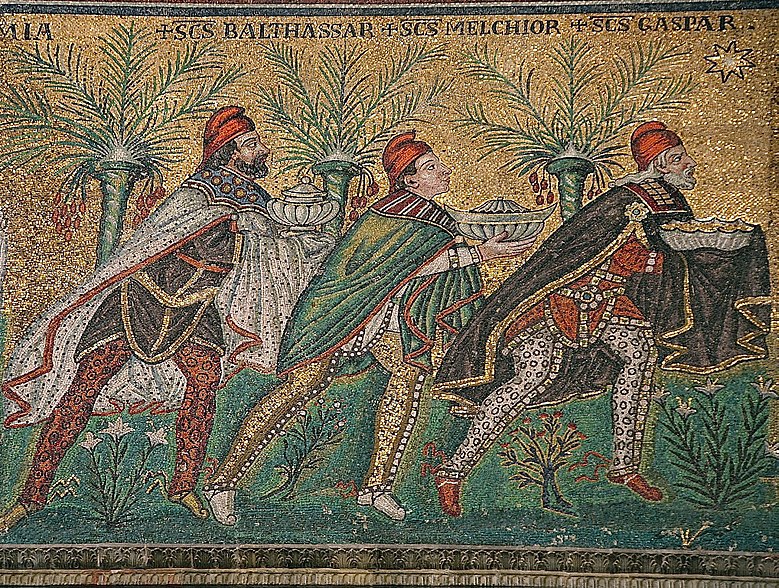
Pentagram
Perhaps the most well-known occult symbol of all times, the pentagram, also dates back to ancient Sumeria. In Sumerian pictographic writing, it was an ideogram used to describe Merovingian Kings as “lofty ones” or “shining ones”, and was presented in its inverted form.
The pentagram’s association with black magic probably derives from the fact that these kings were thought to possess magical powers; so it is both a symbol of their dynasty and their doctrine.
In early (Ur I) monumental Sumerian script, a pentagram glyph served as a logogram for the word ub, meaning “corner, angle, nook; a small room, cavity, hole; pitfall” (this later gave rise to the cuneiform sign UB, composed of five wedges, further reduced to four in Assyrian cuneiform).
In medieval Christian tradition, the pentagram could represent the five wounds of Jesus. In the Renaissance it came to be associated with magic and occultism, and is also found as a magic symbol in the folklore of early modern Germany (Drudenfuss).
In modern use, it is sometimes used as representing the Seal of Solomon, and it has religious significance in various new religious movements (including certain forms of Neopaganism) as well as in occultism.

-
In parts of Mesopotamian religion, magic was believed in and actively practiced. At the city of Uruk, archaeologists have excavated houses dating from the 5th and 4th centuries BCE in which cuneiform clay tablets have been unearthed containing magical incantations.
In ancient Egypt, magic consisted of four components; the primeval potency that empowered the creator-god was identified with Heka, who was accompanied by magical rituals known as Seshaw held within sacred texts called Rw. In addition Pekhret, medicinal prescriptions, were given to patients to bring relief.
This magic was used in temple rituals as well as informal situations by priests. These rituals, along with medical practices, formed an integrated therapy for both physical and spiritual health.
Magic was also used for protection against the angry deities, jealous ghosts, foreign demons and sorcerers who were thought to cause illness, accidents, poverty and infertility. Temple priests used wands during magical rituals.
Egyptians believed that with Heka, the activation of the Ka, an aspect of the soul of both gods and humans, (and divine personification of magic), they could influence the gods and gain protection, healing and transformation. Health and wholeness of being were sacred to Heka.
There is no word for religion in the ancient Egyptian language as mundane and religious world views were not distinct; thus, Heka was not a secular practice but rather a religious observance. Every aspect of life, every word, plant, animal and ritual was connected to the power and authority of the gods.
Magi (Latin plural of magus; Ancient Greek: magos; Old Persian: maguš, Persian: mogh; English singular magian, mage, magus, magusian, magusaean; Kurdish: manji) is a term, used since at least the 6th century BC, to denote followers of Zoroastrianism or Zoroaster.
The earliest known usage of the word Magi is in the trilingual inscription written by Darius the Great, known as the Behistun Inscription.
Starting later, presumably during the Hellenistic period, the word Magi also denotes followers of what the Hellenistic chroniclers incorrectly associated Zoroaster with, which was – in the main – the ability to read the stars, and manipulate the fate that the stars foretold.
However, Old Persian texts, pre-dating the Hellenistic period, refer to a Magus as a Zurvanic, and presumably Zoroastrian, priest.
Pervasive throughout the Eastern Mediterranean and Western Asia until late antiquity and beyond, mágos, “Magian” or “magician,” was influenced by (and eventually displaced) Greek goēs (γόης), the older word for a practitioner of magic, to include astrology, alchemy and other forms of esoteric knowledge.
This association was in turn the product of the Hellenistic fascination for Pseudo-Zoroaster, who was perceived by the Greeks to be the “Chaldean” “founder” of the Magi and “inventor” of both astrology and magic.
Among the skeptical thinkers of the period, the term ‘magian’ acquired a negative connotation and was associated with tricksters and conjurers. This pejorative meaning survives in the words “magic” and “magician”.
In English, the term “magi” is most commonly used in reference to the “μάγοι” from the east who visit Jesus in Chapter 2 of the Gospel of Matthew Matthew 2:1, and are now often translated as “wise men” in English versions.
The plural “magi” entered the English language from Latin around 1200, in reference to these. The singular appears considerably later, in the late 14th century, when it was borrowed from Old French in the meaning magician together with magic.
The Magi, also referred to as the (Three) Wise Men or (Three) Kings were, in the Gospel of Matthew and Christian tradition, a group of distinguished foreigners who visited Jesus after his birth, bearing gifts of gold, frankincense and myrrh.
They are regular figures in traditional accounts of the nativity celebrations of Christmas and are an important part of Christian tradition.
According to Matthew, the only one of the four Canonical gospels to mention the Magi, they were the first religious figures to worship Jesus. It states that “they” came “from the east” to worship the Christ, “born King of the Jews.”
Although the account does not mention the number of people “they” or “the Magi” refers to, the three gifts has led to the widespread assumption that there were three men.
In Eastern Christianity, especially the Syriac churches, the Magi often number twelve. Their identification as kings in later Christian writings is probably linked to Psalms 72:11, “May all kings fall down before him”.
Made famous by the account of the New Testament, by which the were said to have followed a start to the birth of the Christian Messiah, the Magi were priests of the Persian empire, who were renowned throughout antiquity for their knowledge of magic, astrology and alchemy. Thus, our own word for magic refers to the occult arts of the Magi
In truth, though, the Magi known to the Greek and Roman world, were not the same as the official priests of the Persian religion of Zoroastrianism, said to be founded by Zoroaster. For, when we compare the ideas that were attributed to the Magi by ancient writers, we find that they differed widely from what we know of the mainstream version of the religion, as found in its sacred scriptures, the Avesta.
Rather, it would appear that the Greeks had come into contact, not with priests of Zoroastrianism, but the notorious Magussaeans of Asia Minor, in what is now Turkey. These Magussaeans were Persian emigres that found their way to the region after it had come under Persian domination. Speaking the language of Aramaic, rather than Palahvi, they were unable to read their own scriptures in their original tongue, and thereby deviated from the faith.
Basically, the cult of the Magussaeans was a combination of heretical Zoroastrianism and Babylonian astrology. When Cyrus the Great conquered the great city of Babylon in the sixth century BC, the Magi came into contact with the teachings of the city’s astrologers, known as Chaldeans. According to Diodorus of Sicily, a Greek historian of 80 to 20 BC, and author of a universal history, Bibliotheca historica:
“…being assigned to the service of the gods they spend their entire life in study, their greatest renown being in the field of astrology. But they occupy themselves largely with soothsaying as well, making predictions about future events, and in some cases by purifications, in others by sacrifices, and in others by some other charms they attempt to effect the averting of evil things and the fulfillment of the good.
They are also skilled in the soothsaying by the flight of birds, and they give out interpretations of both dreams and portents. They also show marked ability in making divinations from the observations of the entrails of animals, deeming that in this branch they are eminently successful.”
Though astrology has often been regarded as representing an ancient form of knowledge devised by the Babylonians, scholars have now determined that its development was impossible, before the eighth century BC, due to the absence of a reliable system of chronology, and that, more properly, astrology was a product of the sixth century BC. This transformation, according to Bartel van der Waerden, was the result of the influence of Zoroastrianism, with its doctrine that the human soul originated in the stars.
In addition, the sixth century BC is also known in Jewish history as the Exile, when their entire population was located in the city, having been removed to there by Nebuchadnezzar, at the beginning of the century, after he had destroyed Jerusalem.
Having become substantial citizens, with some achieving minor administrative posts, it is possible the Jews also contributed to this development. In fact, in the Book of Daniel, Chapter 2:48, Daniel is made chief of the “wise men” of Babylon, that is of the Magi or Chaldeans. In any case, scholars have certainly recognized that the later teachings referred to collectively as the esoteric Kabbalah, seem to have been a combination of Magian and Chaldean lore.
Astrology was not a component of mainstream Zoroastrianism, and those who incorporated its concepts into their version of the faith seem to have been regarded as heretical. As Edwin Yamauchi describes, “the relationship of the Magi to Zoroaster and his teachings is a complex and controversial issue.”
Ever since the early days of the Persian Empire, there had existed an antagonism with the proponents of true Zoroastrianism and the Magi. And, according the French Assyriologist Lenormant, “to their influence are to be ascribed nearly all the changes which, towards the end of the Achaemenid dynasty, corrupted deeply the Zoroastrian faith, so that it passed into idolatry.”
The Chaldean Magi: A Library of Ancient Sources
Filed under: Uncategorized















